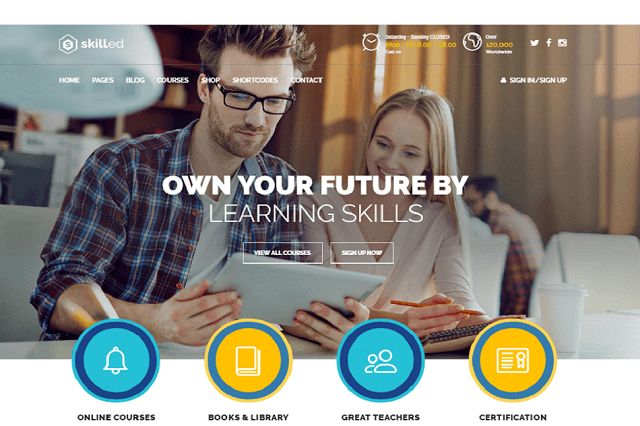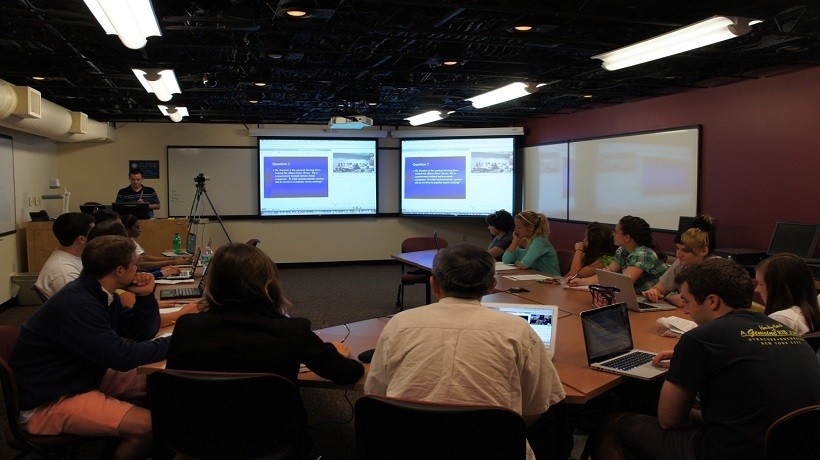The Blended Learning Trends That A Define Higher Education
Over the past few years, education has seen the rise of a hybrid method of learning that combines traditional face-to-face approach with tech-powered e-learning. Both students and educators have agreed on the efficiency and benefits of blended learning method since it combines the best of both worlds allowing less costly, time-saving and more personalized ways of knowledge acquisition. According to the results of an action research study on Adopting a Blended Learning Approach at West Chester University of Pennsylvania, blended approach improved overall student achievement and learning attitude as:
- “the blended section had a slightly higher average score (47.46 out of 60) than both the large, non-blended section (44.34) and the small, non-blended section (47.40)”
- “Sixty-four percent (64%) of the students felt more engaged in the course material with the blended format”
- “90% of the students reported that they liked the convenience of the blended approach, 88% liked working independently at their own pace; 68% felt more comfortable expressing themselves with the blended approach, and 65% felt that the blended activities promoted a learning community, allowing them to interact more easily with other class members”.
As for the author of the study, some of the major takeaways were the following:
“Starting small with a pilot test and keeping in mind that transforming a course to a hybrid format takes time and is an evolving process were important factors in maintaining the author’s motivation to continue. Obtaining professional development funds for training, equipment, and the services of a graduate student assistant helped make the change to blended teaching a successful experience.”
Understanding the importance of technology application in education, colleges and universities around the world have combined online courses and lessons with regular in-person classroom types in order to keep up with the fast-paced lives of their target audience.
The shift the blended learning brought to higher education presents an ongoing process that is continually reshaping the learning process, as a result, several blended learning trends that define higher education of today.
1. Ease Of Access
Firstly, a blended learning system provides several learning models such as flex, self-blend, rotation, and enriched-virtual that could easily meet the needs of any personal student requirement. Therefore, resources students can choose from various methods of digital and face-to-face delivery in order to incorporate quality education with their time and space resources.

As stated in the NMC Horizon Report 2015 Higher Education Edition, this trend resulted from the understanding that students have grown accustomed to having each type of information accessible and delivered online, therefore, learning had to be approached in the same manner so as to be easily integrated into students’ every-day behaviors, and also to encourage creativity and entrepreneurial thinking.
One successful example of blended approach is found at the Philadelphia College of Osteopathic Medicine were students were given the opportunity to join online discussion boards with clinicians and to watch computer-based simulations of different patient scenarios along with the regular in-person training. One of the students, Phil Koehler, who is pursuing his Doctor of Osteopathic Medicine concludes that the blended approach “really expanded the learning environment there.”
This trend has achieved its most important implication in the learning attitude of people living in remote parts of the countries as they are now provided with the opportunity to enroll in graduate or undergraduate programs of their choice. Additionally, the trend has brought about initiatives for the implementation of the blended learning approach in rural areas, and International locations. Australian Country Education Partnership has created and successfully implemented eKids blended program, which “is an accessible, adaptable, contemporary model for rural and remote communities to personalize their students learning, build the capacity of teachers, and improve students learning capacities and outcomes”.
2. Interactive Pedagogy
Secondly, blended approach to learning managed to cause better student engagement which is more difficult to achieve in a traditional classroom. Fast development of Learning Management System platforms and features results in various means to encourage students to take a more active role and employ individual approach in the process of knowledge acquisition, thus creating opportunities for better student collaboration. With data-driven learning and assessment practices accessible via learning analytics, both instructors and students are able to track students’ progress and interaction with material, which provides opportunity for instructors to gain insight and provide timely help to students performing poorly.
3. The Rise In The Development Of Functional Learning Management System Features

With the more cost effective alternatives to enterprise Learning Management System software, such as WordPress web development tools and availability of free resources for setting up an education website, it is becoming easier for local schools and individual tutors to build a great site with minimum investments. Combined with powerful WordPress themes designed specifically for such purposes, functional Learning Management System, pricing and membership management plugins, this opens new opportunities for teachers, tutors and school administrators. Skilled theme, for example, integrates all the necessary functionalities to allow for easy set up and management, which enables even those without many technical skills to develop fully functional school or tutoring website.
4. Cost Effectiveness
One of the most significant quality of this particular trend in blended learning is that it works both ways, meaning that both users and providers of the program can experience cost savings. Students could benefit from reduced transport costs. As for universities, cost effectiveness is achieved through much faster and more effective access to global market as well as by reductions in the physical space requirements.
5. Improved Academic Achievement
Finally, with the benefits of blended learning method such as time/space flexibility and a variety of appropriate learning models which result in better academic achievement, more interaction is being created constantly. Furthermore, this scenario provides tutors and teaching specialists with enough resources to work with smaller groups of students during in-person sessions thus utilizing the time much more efficiently, which, ultimately leads to considerably greater learning satisfaction, and consequently enhances students’ overall performance.
Blended learning method bridges the way between two considerably different approaches providing significant improvements to each element and participant in the educational process. Together with reductions in cost, time and space and improvement of the students’ academic achievement, it also creates opportunities for advancement in the digital resources and solutions to construct as efficient learning platforms as possible.










